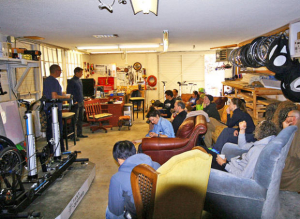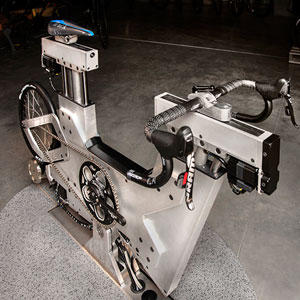
Describe for me your “pathway to purchase?” This is what I often ask a brand manager who asks my advice and this cuts right to the quick. I just feel like hitting my head against a wall when I come across brands who don’t understand this. This is especially true when it’s the primary reason the company isn’t prospering.
Case in point. I visited GURU in 2005, back when this company’s business was simply making custom bikes. At that time they felt their competition was Cervelo but I told them I thought it was Serotta. (The only parallel to Cervelo is that both brands were Canadian.) GURU’s business was much more like Serotta’s, in that both were custom bike makers. What GURU lacked was a system and that’s what Serotta had.
Now, to be clear, I had problems with Serotta’s system back then, but it was a system, i.e., it was a pathway to purchase. What I recommended to GURU was, first, that it make a system of its own and second, a better system. Out of that meeting came (3 years later) the GURU fit bike and a protocol that guided a consumer to a tailored solution. Alas, the problems at GURU were too deep and advanced, but, I relate this anecdote for this reason: In my opinion, Serotta’s preeminent place among custom bike makers in the late 90s and early 2000s was not due to its product, but to its sales process. What Serotta engaged in was “prescriptive selling” and the sexiest, most intoxicating, most successful pathway to purchase is a prescriptive process that invites you to sit on a Disneyland-like ride that delivers you from beginning to end. When you reach the end the only thing you need to do is pay.
I’m all for systems like these! But… at best they predict in advance your needs and provide a Google Map turn-by-turn pathway to your perfect product. At worst they seduce you into thinking that a product is just right for you when in fact the turn-by-turn directions are built on faulty or just plain made-up data.

Let me give you an example of a pair of processes that confused me. Fizik built a way for you to choose your perfect saddle. Their prescriptive process told you that you were a Snake, Bull or a Chameleon, which were 3 ways to describe your spinal flexibility and posture aboard the saddle. Once you identified yourself, presto(!), here’s your perfect saddle. Meanwhile, the Specialized system featured a tool that measured the width of your sit bones and told you what it thought your perfect saddle was. Note that one system measured your trunk across the coronal plane, the other than sagittal plane. The confusing part: How can both these measuring systems be soundly based when each system completely ignores what the other system says is the vital metric?
Gebiomized pressure maps you on the saddle, and this is its “pathway to purchase”: Your perfect saddle is one that doesn’t generate hot spots. At least this system is built on a process that makes some intuitive sense.
The problem with prescriptive systems is that any system, when it’s the only system, is like the one-eyed man in the land of the blind. That man, though vision impaired, is the king. A faulty prescriptive system is king in the land of no other pathways to purchase. How do you know if a particular system, filtering out everything but your perfect bicycle, saddle, running shoe, diet, drug therapy is helpful? Versus the one-eyed prescriptive system in the land of the blind?
Whenever I teach a workshop to bike fitters I always begin with an hour of discussion on what underpins my views. If you don’t buy what I consider axiomatic – if you don’t stipulate to my belief structure then you should ask for a refund, not waste your time, and leave. You should always consider what axioms underpin any system over which you’ve given yourself. For example…
Do you believe it is self-evident that all men are created equal, and are endowed by their Creator with certain unalienable Rights, among these life, liberty and the pursuit of happiness? (Self-evident means axiomatic.) Think hard before you answer, because, in certain countries and cultures that is not true. Some countries believe the state is more important than the individual and perhaps you believe this. If so my country, America, is a place that begins with a set of axioms you just don’t believe in. Majorities in many countries believe that the tenets of their religion supersede equality, democracy, women’s rights, sexual preference rights, religious freedoms. Schoolboards right now in my country are fighting over what constitutes a set of axioms that define and circumscribe how children are taught.

So, no, we don’t all agree worldwide on a set of axioms that describe everyday life. But systems for sporting purposes should be easier to scrutinize because – for example – miracles aren’t a factor in swim, bike and run. We don’t have to worry about religion and politics or who’s really spreading fake news. We all agree – I think – that your bike saddle shouldn’t be too high or too low. And we pretty much all agree what too high or too low looks like, because we all pretty much stipulate to what makes a saddle height correct. And we can make that into an axiom! Which is: Most people do most things on a bike the same way; and that way is – most of the time – a safer bet than some kind of outlier technique.
Let me show you how to use this as a guide. Does a system tend to lead you toward the behavior that most good athletes engage in most of the time? For example, does a coaching system, or a way to figure out your proper training or racing nutrition, or a diet for your breakfast, lunch and dinner meals, lead you toward “consensus” behavior? Or does it try to steer you away from it? Let’s consider another example. A Slowtwitcher, Dr. Alex Harrison, has an app available that is designed to prescribe for you your ideal training and racing nutrition. The app, called Saturday, asks questions that could reasonably be used to calculate a nutrition plan (age, weight, activity type, gender, sweat rate and so on). I’ve included several screen shots above because this highly prescriptive program tends to erect guardrails funneling you into a conforming regimen, rather than recommending Uruguayan Ginger Ale spiked with eye of newt once every 45 minutes during cycling. Secondly, look at the output: a bunch of products not made or sold by Saturday!
That’s the difference between a system that honors what we think we’ve learned over the years versus… well… a cult. There are 3 ways you can be led by a prescriptive system. One is toward mainstream healthy ideas of bike position, diet, training and so on. The second is toward some person’s cultish idea, which for some reason he or she feels it’s necessary for you to engage in too. The third is all too common: a system designed to port you into “the perfect product for you” based on any methodology that will get you to buy that company’s product. Mind, I am not recommending Saturday. I’m not a user (as of this moment at least), and Saturday is not a partner here at this site (or of mine personally). I just point this out as an example of a prescriptive system – a glide path to products you’ll want to consider purchasing – that passes the smell test.
That is of course another way to know you’re getting duped by a system designed only to help the company sell you its product, rather than a system designed to help you find the perfect product: Is the output of that system always a product made by a particular brand? So, back to saddles. Gebiomized, yes, makes saddles, but the system itself is designed to be ecumenical (my word for brand independent). The output of a Gebiomized pressure mapping session generates color coded maps and you can put those pressure pads on any saddle, whether or not made by that company.

Now we have a pair of tools that could help you know whether a pathway to purchase is trustworthy: First, does it end up prescribing a product or a behavior that draws you closer to known best practices exhibited by the majority of folks worth emulating? And does that process by which you’re supposed to choose a diet, a bike, a saddle, a training system, output a recommendation that is not tied to the system outputting the recommendation?
I began with an example: GURU. Not long after its fit bike – a terrific tool, pictured above – was built, it was spun off to the parent company of Cannondale. It became the king of prescriptive bike fitting systems when used by a good bike fitter. It did 2 things: It drew you toward a consensus position, that is, it gave you every opportunity to ride in a bike position recognizable as a position you might see pros ride in the IRONMAN or in the Tour de France. And, the output was ecumenical. That system told you not just what Cannondales would work, but what Treks, Cervelos and Giants would work. In fact, because the system drew you toward a normal, conforming position the likelihood that you could ride a bike made by these companies, with a non-weird front end (e.g., mountains of spacers, stem angled to the sky) was much greater.



